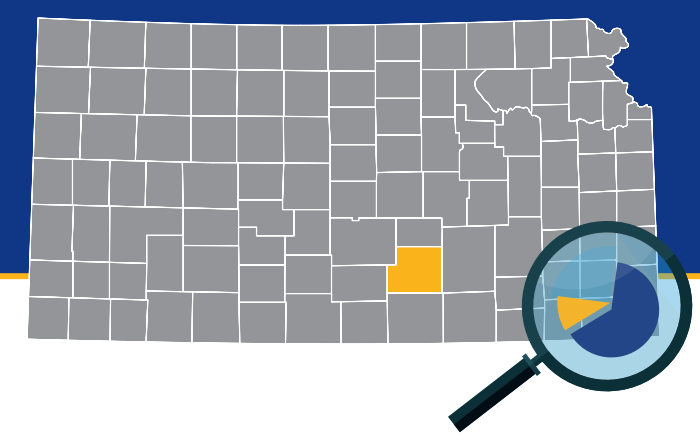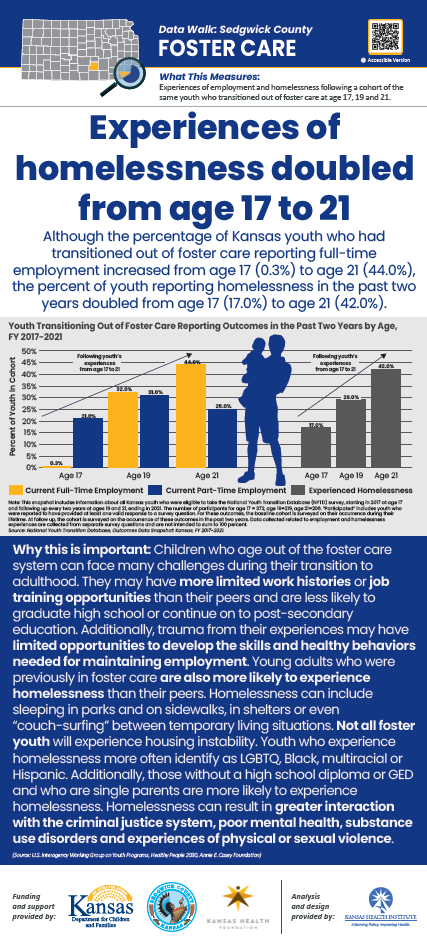Foster Care Removals by Primary Removal Reason
What This Measures
The primary reason children are removed from their homes into foster care by age group.
One-third of Removals
Although abuse was the most common reason for removal in Sedgwick County across all age groups, one-third (34.9%) of all removals were identified as families in need of assessment (FINA) or cases with the presence of substances or drug use, domestic violence, behavior problems, incarceration or death of a parent, inadequate housing or conditions that require additional agency assessment and community supports.
Stacked Bar Chart: Primary Reason for All Removals into Foster Care in Sedgwick County by Age Group, SFY 2023
Infants and Toddler (0-3 Years)
- Abuse: 8.7 percent of children removed into foster care
- Parent Substance Use: 11.9 percent of children removed into foster care
- Lack of Supervision: 5.9 percent of children removed into foster care
- Caretakers Inability to Cope: 4.8 percent of children removed into foster care
- Neglect: 3.6 percent of children removed into foster care
- Other: 2.0 percent of children removed into foster care
- Abandonment: 1.2 percent of children removed into foster care
- Incarceration of Parent : 1.7 percent of children removed into foster care
Child (4-11 Years)
- Abuse: 12.4 percent of children removed into foster care
- Parent Substance Use: 4.5 percent of children removed into foster care
- Lack of Supervision: 7.4 percent of children removed into foster care
- Caretakers Inability to Cope: 2.8 percent of children removed into foster care
- Neglect: 2.8 percent of children removed into foster care
- Other: 3.4 percent of children removed into foster care
- Abandonment: 1.2 percent of children removed into foster care
- Incarceration of Parent: 1.2 percent of children removed into foster care
Teen (12-17 Years)
- Abuse: 7.3 percent of children removed into foster care
- Parent Substance Use: 2.2 percent of children removed into foster care
- Lack of Supervision: 2.6 percent of children removed into foster care
- Caretakers Inability to Cope: 3.3 percent of children removed into foster care
- Neglect: 2.2 percent of children removed into foster care
- Other: 1.9 percent of children removed into foster care
- Abandonment: 4.0 percent of children removed into foster care
- Incarceration of Parent: 0.8 percent of children removed into foster care
All (0-17 Years)
- Abuse: 28.4 percent of children removed into foster care
- Parent Substance Use: 18.6 percent of children removed into foster care
- Lack of Supervision: 16.0 percent of children removed into foster care
- Caretakers Inability to Cope: 10.9 percent of children removed into foster care
- Neglect: 8.5 percent of children removed into foster care
- Other: 7.3 percent of children removed into foster care
- Abandonment: 6.5 percent of children removed into foster care
- Incarceration of Parent: 3.9 percent of children removed into foster care
34.9 percent of all removals in Sedgwick County are from families in need of assessment (FINA) prior to removal. Not every reason for removal will result in FINA. Infant and Toddler 47.1%, Child 30.7, Teen 22.2%
Note: Total number of children removed into foster care in SFY 2023 in Sedgwick County = 645. Of these 645 children, 225 (34.9 percent) were removed from families in need of assessment (FINA). FINA can include cases with presence of substances or drug use, domestic violence, behavior problems, incarceration or death of a parent, inadequate housing or when a child runs away. Summary-level categorizations developed in collaboration with Wichita Area DCF Office. “Abuse” includes “physical abuse,” “sexual abuse” and “emotional abuse.” “Parent substance use” includes “alcohol abuse parent,” “drug abuse parent,” “methamphetamine use,” “parent opioid use,” “infant positive for substances” and “substance-affected infant.” “Neglect” includes “physical neglect,” “medical neglect” and “educational neglect.” “Other” includes “death of parents,” “inadequate housing,” “runaway,” “child’s behavior problem,” “drug abuse by child” and “domestic violence.”
Source: Kansas Health Institute analysis of data requested from Kansas Department for Children and Families, SFY 2023.
Why This Is Important
Across Kansas, children are most often removed from their homes due to abuse or neglect. Abuse is any physical or emotional injury, physical neglect or sexual act inflicted on a child. Neglect includes acts or omissions by a parent or guardian that could include failing to provide food, shelter, clothing, responsive medical care or supervision. These adverse childhood experiences can have lasting impacts on a child’s health, opportunity and well-being. Child abuse and neglect are preventable. Protective factors such as community supports, economic stability, strong family and community relationships and access to basic needs can help lessen the likelihood of children being abused or neglected. Children living in poverty experience more abuse and neglect than families with higher socioeconomic status. Policies and strategies aimed to alleviate poverty, support parents, provide high-quality early child care and education and increase access to physical and behavioral health services can help prevent child abuse and neglect.
Source: Kansas Department for Children and Families, Centers for Disease Control and Prevention.
Funding and Support Provided by:
- Kansas Department for Children and Families
- Sedgwick County Kansas
- Kansas Health Foundation
Analysis and Design Provided by:
Kansas Health Institute
Return to Table of Contents









